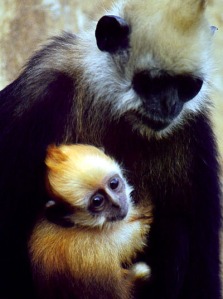One of the most frequent questions we get on the Emeraude, especially after passengers have visited the grottos of Surprise Cave, and walked the boardwalk back to our tender, is about monkeys. What kind of monkey was that, clambering over the limestone rocks, and harassing passengers for hand-outs?
That monkey is a macaque. Now, we don’t mean to downplay anyone’s enthusiasm for an encounter with this primate, but of all the monkeys in Vietnam, this one is the least interesting. Monkey Island in Cat Ba is populated by macaques introduced for tourism.
Disappointed? Perhaps, and we’re sorry your encounter with the macaques isn’t anything to text home about. But here’s some better news from Jeremy Parker, Programme Officer at Fauna & Flora International, whom I met over a glass of wine at the Press Club in Hanoi recently. “Vietnam is one of the most important places on earth for primates, with at least 24 species, many of which occur only in Vietnam. It is also one of the worst places to be a primate, as Vietnam holds 5 of the top 25 most threatened primates species globally.” And Halong Bay is part of the reason why.
There are seven critically endangered primates in Vietnam: the western black-crested gibbon, the cao vit gibbon, the northern white-cheeked gibbon, the gray-shanked douc, the Tonkin snub-nosed monkey, Delacour’s langur, and the golden-headed langur. It is the golden-headed langur that has a connection to Halong Bay, for there is a population living in Cat Ba National Park. Cat Ba is the biggest island you’ll see as you voyage through Halong Bay on Emeraude Classic Cruises.
There are only about 55-60 of these primates left in the world, and all of them live on Halong Bay. Unlike the aggressive macaque, the langur is a gentle soul, living on leaves, flowers and fruits in the national park and an area near Cat Ba town. Can you spot one from the deck of the Emeraude? Not likely.
“The National Park is off limits to visitors,” said Jeremy, “although a few groups can sometimes be seen near Ben Beo harbour if you know when and where to look.”
The Cat Ba langur is so threatened because of past hunting pressure on the species. As recently as the 1960s there may have been as many as 2400-2700 langurs on Cat Ba Island. Only through conservation efforts of Fauna & Flora International’s partner, the Cat Ba Conservation Project, over the last 14 years has the species been saved from complete extinction.
Conservationists are really interested in the survival of this monkey, and so are we on the Emeraude. Why? Well, we’ll let Jeremy speak for us:
“In esoteric or metaphysical terms, these things have evolved over many years, and they are kind of mystical. These are creatures have been entrusted to the world, and they’re disappearing.”
“If you believe in a better world for tomorrow, these flagship species are extremely important. Primates are us. When you look at a primate, you feel something. If you have children, you’d want them to see them.”
By The Emeraude’s Captain
